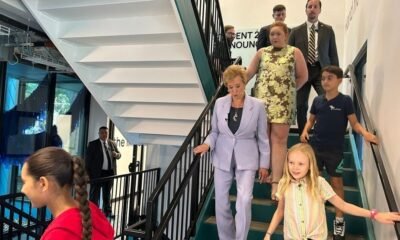Education
Classover Launches AI Learning Genome for K-12 Education Platform
Classover (NASDAQ:KIDZ) has launched its AI Learning Genome in a secure AWS sandbox environment, marking a significant step toward creating an AI tutor with long-term memory capabilities. This innovative system securely stores and builds upon each student’s learning interactions, creating a structured “growth archive” of educational progress.
CEO Stephanie Luo emphasized that this technology will transform fragmented lessons into a comprehensive educational journey. The Learning Genome aims to preserve every lesson, question, and achievement as part of a lasting educational record, offering parents enhanced transparency into their children’s learning progress.
This development positions Classover as a pioneer in AI-powered education, establishing a framework where learning data becomes the foundation for continually refined, personalized instruction.
Classover (NASDAQ:KIDZ) ha lanciato il suo AI Learning Genome in un ambiente sandbox sicuro di AWS, segnando un passo importante verso la creazione di un tutor IA dotato di memoria a lungo termine. Questo sistema innovativo archivia in modo sicuro e costruisce sulla base delle interazioni di apprendimento di ogni studente, creando un archivio di crescita strutturato del progresso educativo.
La CEO Stephanie Luo ha sottolineato che questa tecnologia trasformerà lezioni frammentate in un percorso educativo completo. Il Learning Genome mira a conservare ogni lezione, domanda e risultato come parte di un fascicolo educativo duraturo, offrendo ai genitori una maggiore trasparenza sul progresso di apprendimento dei propri figli.
Questo sviluppo posiziona Classover come pioniere nell’istruzione guidata dall’IA, creando un quadro in cui i dati di apprendimento diventano la base per un’istruzione personalizzata e continuamente affinata.
Classover (NASDAQ:KIDZ) ha lanzado su AI Learning Genome en un entorno seguro de sandbox de AWS, marcando un paso significativo hacia la creación de un tutor de IA con capacidad de memoria a largo plazo. Este sistema innovador almacena de forma segura y se apoya en cada interacción de aprendizaje de los estudiantes, creando un archivo de crecimiento estructurado del progreso educativo.
La directora ejecutiva Stephanie Luo señaló que esta tecnología transformará lecciones fragmentadas en un recorrido educativo integral. El Learning Genome busca conservar cada lección, pregunta y logro como parte de un registro educativo duradero, ofreciendo a los padres una mayor transparencia sobre el progreso de aprendizaje de sus hijos.
Este desarrollo posiciona a Classover como pionero en la educación impulsada por IA, estableciendo un marco en el que los datos de aprendizaje se convierten en la base para una instrucción personalizada y continuamente refinada.
Classover(나스닥:KIDZ)는 AWS의 안전한 샌드박스 환경에서 AI Learning Genome을 시작했으며, 장기 기억 기능을 가진 AI 튜터를 만드는 중요한 진전에 도달했다. 이 혁신적인 시스템은 각 학생의 학습 상호작용을 안전하게 저장하고 그 위에 구축하며, 교육 진행 상황의 체계적인 “성장 기록”을 만든다.
CEO Stephanie Luo는 이 기술이 산재된 수업을 포괄적인 학습 여정으로 바꿀 것이라고 강조했다. Learning Genome은 모든 수업, 질문, 성취를 지속 가능한 교육 기록의 일부로 보존하는 것을 목표로 하며, 부모에게 자녀의 학습 진행에 대한 투명성을 향상시켜 줄 것이다.
이 개발은 Classover를 AI 기반 교육의 선두주자로 자리매김시키며, 학습 데이터가 지속적으로 다듬어지고 개인화된 지시의 기초가 되는 프레임워크를 확립한다.
Classover (NASDAQ:KIDZ) a lancé son AI Learning Genome dans un environnement sandbox sécurisé AWS, marquant une étape importante vers la création d’un tuteur IA doté d’une mémoire à long terme. Ce système innovant stocke et se nourrit en toute sécurité des interactions d’apprentissage de chaque élève, créant une archive de progression éducative structurée, dite « archive de croissance ».
La PDG Stephanie Luo a souligné que cette technologie transformera des leçons fragmentées en un parcours éducatif global. Le Learning Genome vise à préserver chaque leçon, chaque question et chaque réussite dans un dossier éducatif durable, offrant aux parents une meilleure transparence sur les progrès d’apprentissage de leurs enfants.
Ce développement positionne Classover comme pionnier dans l’éducation pilotée par l’IA, établissant un cadre où les données d’apprentissage deviennent la base d’instructions personnalisées et continuellement affinées.
Classover (NASDAQ:KIDZ) hat sein AI Learning Genome in einer sicheren AWS-Sandbox-Umgebung gestartet und damit einen bedeutenden Schritt in Richtung eines KI-Tutors mit Langzeitgedächtnis gemacht. Dieses innovative System speichert sicher und baut auf den Lerninteraktionen jedes Schülers auf, und erstellt ein strukturiertes “Wachstumsarchiv” des Bildungsfortschritts.
CEO Stephanie Luo betonte, dass diese Technologie fragmentierte Lektionen in eine umfassende Bildungsreise verwandeln wird. Das Learning Genome zielt darauf ab, jede Lektion, Frage und Leistung als Teil eines bleibenden Bildungsdokuments zu bewahren und den Eltern mehr Transparenz über den Lernfortschritt ihrer Kinder zu bieten.
Diese Entwicklung positioniert Classover als Pionier in der KI-gesteuerten Bildung und schafft einen Rahmen, in dem Lernendaten die Grundlage für kontinuierlich verfeinerte, personalisierte Anleitungen bilden.
أطلقت Classover (المدرجة في ناسداك: KIDZ) AI Learning Genome في بيئة sandbox آمنة على AWS، مما يمثل خطوة مهمة نحو إنشاء مُدرِّس ذكاء اصطناعي ذا ذاكرة طويلة الأمد. هذا النظام المبتكر يخزن بأمان ويتراكم على كل تفاعل تعليمي للطالب، مكوّناً “أرشيف نمو” من التقدّم التعليمي بشكل منظم.
أكّدت الرئيسة التنفيذية ستيفاني لُو أن هذه التكنولوجيا ستحوّل الدروس المجزأة إلى مسار تعليمي شامل. يهدف Learning Genome إلى الاحتفاظ بكل درس، سؤال، وإنجاز كجزء من سجل تعليمي دائم، مما يوفر للآباء شفافية أكبر في تقدم تعلم أطفالهم.
هذا التطور يجعل Classover رائدًا في التعليم المعتمد على الذكاء الاصطناعي، وهو يضع إطاراً تصبح فيه بيانات التعلم أساساً لتعليم مخصص ومحسن باستمرار.
Classover(纳斯达克代码:KIDZ) 已在 AWS 安全的沙箱环境中推出其 AI Learning Genome,标志着朝着具备长期记忆能力的人工智能导师迈出的重要一步。该创新系统能够安全地存储并建立在每位学生的学习互动之上,创建一个结构化的教育进展“成长档案”。
首席执行官 Stephanie Luo 强调,这项技术将把零散的课程转化为一个全面的教育旅程。Learning Genome 旨在把每一课、每一个问题和每一次成就都保留为持续的教育记录的一部分,为家长提供更高的透明度,以了解子女的学习进展。
这一发展使 Classover 成为 AI 驱动教育的先驱,建立一个学习数据成为持续优化、个性化教学基础的框架。
Positive
- First-mover advantage in implementing AI with long-term memory for education
- Secure AWS-powered infrastructure ensures data protection
- Enhanced personalization capabilities for student learning
- Improved transparency for parents tracking educational progress
Negative
- Currently only launched in sandbox environment, not fully implemented
- Success of the technology remains unproven in real-world applications
Insights
Classover’s AI Learning Genome represents a strategic advancement in personalized education technology, potentially creating competitive differentiation in the growing edtech market.
Classover’s introduction of the AI Learning Genome marks a significant technological advancement in educational AI. Unlike conventional edtech solutions that treat learning sessions as isolated events, this development creates a persistent memory architecture for their AI tutor platform. By implementing this in a secure AWS sandbox environment first, the company is taking a measured approach to deployment while addressing the critical data security concerns inherent in educational technology.
The concept of an AI system that maintains comprehensive learning histories represents a fundamental shift in personalized education delivery. Traditional adaptive learning platforms typically rely on point-in-time assessments rather than longitudinal learning patterns. By preserving the entire interaction history between student and AI, Classover is building technological infrastructure for truly personalized instruction that more closely mirrors how human teachers develop relationships with students over time.
This development positions Classover as a potential first-mover in long-term memory AI tutoring systems. While the educational technology market is crowded with adaptive learning solutions, few have successfully implemented persistent memory architectures that maintain comprehensive student histories. The ability to recall past learning challenges, breakthroughs, and patterns could create meaningful differentiation in an increasingly competitive market.
From a product development perspective, this represents an evolution rather than revolution – the technology is launching in a controlled sandbox rather than immediately deploying to the full user base. However, the market for AI-powered educational tools continues to expand rapidly, and establishing early leadership in memory-enabled tutoring could strengthen Classover’s competitive position against both established players and emerging startups in the K-12 educational technology sector.
NEW YORK, NY / ACCESS Newswire / September 15, 2025 / Classover Holdings, Inc. (Nasdaq:KIDZ; KIDZW) (“Classover” or the “Company), a leading provider of K-12 educational AI, today announced the launch of its AI Learning Genome in a secure sandbox environment powered by Amazon Web Services.
The initiative is the Companys first step toward equipping its AI Tutor with long-term memory – enabling it to recall and build upon each child’s unique learning journey. Within the sandbox, every student-AI interaction is securely preserved, forming a structured “growth archive” that captures learning milestones, challenges, and breakthroughs over time. The Company believes this will significantly enhance personalized learning.
“Education is not a series of isolated lessons – it’s a lifelong journey. By treating each child’s learning record as a living archive, we are laying the foundation for truly personalized instruction,” said Stephanie Luo, CEO of Classover. “Just as genomes encode the blueprint of life, the Learning Genome captures the blueprint of a child’s education.”
For parents, the AI Learning Genome is designed to ensure that a child’s educational story is no longer fragmented or forgotten. Each lesson, question, and achievement becomes part of a lasting record, offering greater transparency and confidence in how their child is growing.
The sandbox launch also reflects Classover’s broader vision: to establish a new framework for AI-powered education where data is not just consumed, but preserved, studied, and used to continually refine instruction. By taking this first step, Classover signals its commitment to shaping AI tutors that feel less like software – and more like real teachers who remember.
As adoption of AI in education accelerates worldwide, Classover believes its introduction of the AI Learning Genome positions it as a first mover in setting a new standard: treating learning data not as disposable, but as the foundation of a lifelong educational roadmap.
About Classover
Founded in 2020 and headquartered in New York, Classover (Nasdaq: KIDZ) is a pioneer of online and AI-powered K-12 education solutions. From live tutoring to cutting-edge AI research, Classover empowers students, parents, and schools with accessible, high-quality learning experiences worldwide.
Forward-Looking Statements
This press release contains “forward-looking statements” within the meaning of the safe harbor provisions of the U.S. Private Securities Litigation Reform Act of 1995. Forward-looking statements are neither historical facts nor assurances of future performance. Instead, they are based only on Classover’s current beliefs, expectations and assumptions regarding the future of Classover’s business, future plans and strategies, projections, anticipated events and trends, the economy and other future conditions. Because forward-looking statements relate to the future, they are subject to inherent uncertainties, risks and changes in circumstances that are difficult to predict and many of which are outside of Classover’s control including, but not limited to: Classover’s ability to execute its business model, including obtaining market acceptance of its products and services; Classover’s financial and business performance, including financial projections and business metrics and any underlying assumptions thereunder; Classover’s ability to maintain the listing of its securities on Nasdaq; changes in Classover’s strategy, future operations, financial position, estimated revenue and losses, projected costs, prospects and plans; Classover’s ability to attract and retain a large number of customers; Classover’s future capital requirements and sources and uses of cash; regulatory changes related to crypto assets; fluctuations in the price of crypto assets; risks related to the custody of crypto assets, including security risks; Classover’s ability to attract and retain key personnel; Classover’s expectations regarding its ability to obtain and maintain intellectual property protection and not infringe on the rights of others; changes in applicable laws or regulations; and the possibility that Classover may be adversely affected by other economic, business, and/or competitive factors. These risks and uncertainties also include those risks and uncertainties indicated in the Classover’s filings with the SEC. Classover’s actual results and financial condition may differ materially from those indicated in the forward-looking statements. Therefore, you should not rely on any of these forward-looking statements.
Any forward-looking statement made by Classover in this press release is based only on information currently available to Classover and speaks only as of the date on which it is made. Classover undertakes no obligation to publicly update any forward-looking statement, whether written or oral, that may be made from time to time, whether as a result of new information, future developments or otherwise.
Contacts:
Classover Holdings Inc.
ir@classover.com
800-345-9588
SOURCE: Classover Holdings, Inc.
View the original press release on ACCESS Newswire
FAQ
What is Classover’s (KIDZ) AI Learning Genome and how does it work?
Classover’s AI Learning Genome is a system that creates a structured ‘growth archive’ of student-AI interactions, storing learning milestones, challenges, and breakthroughs over time to enable personalized instruction through long-term memory capabilities.
How does Classover’s (KIDZ) new AI technology benefit students and parents?
The technology creates a comprehensive record of each student’s educational journey, allowing for more personalized instruction while providing parents with improved transparency and tracking of their child’s learning progress.
When will Classover (KIDZ) implement the AI Learning Genome beyond the sandbox environment?
The press release does not specify a timeline for full implementation beyond the current sandbox environment powered by AWS.
What security measures does Classover (KIDZ) use to protect student data?
Classover’s AI Learning Genome operates in a secure sandbox environment powered by Amazon Web Services (AWS), ensuring student interactions are securely preserved.
How does Classover’s (KIDZ) AI Learning Genome differ from traditional educational software?
Unlike traditional educational software, the AI Learning Genome preserves and builds upon past interactions, treating learning data as a foundation for ongoing personalized instruction rather than disposable information.
Education
Why AI’s true power in education isn’t about saving time

Key points:
- When we frame AI as a creative partner rather than a productivity tool, something shifts
- 5 ways to infuse AI into your classroom this school year
- In training educators on AI, don’t outsource the foundational work of teaching
- For more on AI’s role in education, visit eSN’s Digital Learning hub
As a former teacher, educator coach, and principal, I’ve witnessed countless edtech promises come and go. The latest refrain echoes through conference halls and staff meetings: “AI saves teachers X hours a week.” While time is undeniably precious in our profession, this narrative sells both educators and students short. After years of working at the intersection of pedagogy and technology, I’ve come to believe that if we only use AI to do the same things faster, we’re not innovating–we’re just optimizing yesterday.
The real opportunity: From efficiency to impact
Great teaching has never been about efficiency. It’s iterative, adaptive, and deeply human. Teachers read the room, adjust pace mid-lesson, and recognize that moment when understanding dawns in a student’s eyes. Yet most AI tools flatten this beautiful complexity into task lists: generate a worksheet, create a quiz, save time, done.
The question we should be asking isn’t, “How do I get through prep faster?” but rather, “What would I try if I didn’t have to start from scratch?”
Consider the pedagogical best practices we know drive student success: timely personalized feedback, inquiry-based learning, differentiation, regular formative assessments, and fostering metacognition. These are time-intensive practices that many educators struggle to implement consistently–not for lack of desire, but for lack of bandwidth.
AI as a pedagogical ally
When AI is truly designed for education–not just wrapped around a large language model–it becomes a pedagogical ally that reduces barriers to best practices. I recently observed a teacher who’d always wanted to create differentiated choice boards for her diverse learners but never had the time to build them. With AI-powered tools that understand learning progressions and can generate standards-aligned content variations, she transformed a single instructional idea into personalized pathways for 30 students in minutes, then spent her saved time having one-on-one conferences with struggling readers.
This is the multiplier effect. AI didn’t replace her professional judgment; it amplified her impact by removing the mechanical barriers to her pedagogical vision.
Creativity unleashed, not automated
The educators I work with already have innovative ideas, but often lack the time and resources to bring them to life. When we frame AI as a creative partner rather than a productivity tool, something shifts. Teachers begin asking: What if I could finally try project-based learning without spending weekends creating materials? What if I could provide immediate, specific feedback to every student, not just the few I can reach during class?
We’ve seen educators use AI to experiment with flipped classrooms, design escape room reviews, and create interactive scenarios that would have taken days to develop manually. The AI handles the heavy lifting of content generation, alignment, and interactivity, while teachers focus on what only they can do: inspire, connect, and guide.
Educators are the true catalysts
As we evaluate AI tools for our schools, we must look beyond time saved to amplified impact. Does the tool respect teaching’s complexity? Does it support iterative, adaptive instruction? Most importantly, does it free educators to do what they do best?
The catalysts for educational transformation have always been educators themselves. AI’s purpose isn’t to automate teaching, but to clear space for the creativity, experimentation, and human connection that define great pedagogy. When we embrace this vision, we move from doing the same things faster to doing transformative things we never thought possible.
Education
What National Endowment for the Humanities cuts mean for high schoolers like me

In April, the Trump administration announced drastic funding cuts to the National Endowment for the Humanities. Those cuts are harming education groups that rely on NEH grants — and students like me.
Among the organizations that lost funding was National History Day, a nonprofit that runs a half-century-old competition engaging some 500,000 students annually in original historical research. It also provides teachers with resources and training. For many schools, the annual event is cemented into the social studies curriculum.
The cuts sliced $825,000 from National History Day’s budget over several years, the group said. Meanwhile, more than half of its state-level competitions rely in part or entirely on funding from state humanities councils — which were also devastated by the cuts.
Without that money, National History Day’s leaders say some states will likely have to cancel their programs altogether, and the national event will be scaled back, too.
The loss of funding is discouraging to me, a high school senior in Texas who has witnessed the passage of legislation in my state and around the country in recent years limiting what can be taught in history and social studies classes. National History Day allowed me the chance to expand on what I felt was missing or inaccurate in my textbooks. The fact that there might no longer be a structured way for students to navigate incomplete curricula feels scary and is an intentional part of a broader effort by lawmakers to change how history is understood and what students can know about their past.
Related: Become a lifelong learner. Subscribe to our free weekly newsletter featuring the most important stories in education.
At my sixth to 12th grade school in El Paso, Texas, History Day is an annual event that all middle school students participate in from September to January. They choose their topics and presentations and work to research and create a finished project as historians.
In February, we hold a schoolwide competition, a highly anticipated event in which high schoolers serve as judges and mentors for middle school projects, ultimately deciding which students advance. High schoolers automatically advance. We have become known locally as an “NHD school” and fostered a community of students who love history.
I have participated in local and state History Day fairs since seventh grade, and the program allowed me to grow as a writer and researcher. In my junior year, I wrote a paper about British imperialism and how it led to violence during the 1947 Partition between India and Pakistan, and the lasting divisions today.
I scoured dozens of oral histories of Partition survivors, including interviewing family members about their experiences. The self-guided nature of National History Day, the resources from my El Paso branch, and the support from my history teacher made my paper more than a project — but a connection with my Pakistani identity. I was able to go beyond just learning about the Partition, but also understanding how it shaped my family’s lives.
Related: A school district singled out by Trump says it teaches ‘whole truth history’
Many other students have had similar experiences with the program.
National History Day “is a way to explore a niche or smaller area of history that I wouldn’t be able to as deeply in a classroom,” said Tessa Kipnis, a high school senior at Westtown School in Pennsylvania, who wrote her project on the Rwandan genocide and France’s role in it. “It’s helped me to expand upon my passion for storytelling and self-motivated research.”
Added Kipnis: “It’s the student-led inquiry that is really going to dissipate with the funding being cut. And I feel with our current situation with the Department of Education and the funding and lack thereof, it’s hard not to view this funding being cut as part of a bigger piece.”
Many communities may be able to raise money to keep their local programs going. But even if my local or state National History Day programs continue, I know that not all communities will have the same resources. In turn, the national event will be missing vital perspectives of students, especially those from low-income and marginalized communities.
Part of what makes History Day so special is interacting with other projects and building community with other students. Now, it feels exclusive.
Anita Kuriakose, a high school junior at Academies at Englewood in New Jersey, told me she shares those concerns. “[NEH funding cuts] may cause other students to be cut from the research experience, and not be able to gain more insight into historical perspectives. Students won’t be given the chance to think creatively or research more about history outside the classroom.”
Related: Teachers struggle to teach the Holocaust without running afoul of new ‘divisive concepts’ rules
Lynne O’Hara, deputy director of educational programs at National History Day and a former social studies teacher, also told me that National History Day hinges on accessibility. “History Day is a program that should be available to all students,” she said.
“Sometimes in education, we’re just pushed to do so much and give students a little taste of all these things. But you get one topic that you really have control over and command over, and I think that really empowers students,” added O’Hara. “When I would ask my students on the last day, ‘What’s the thing you did that you were most proud of in this class?’ Ninety-nine percent of them said, ‘It was my History Day project.’”
O’Hara told me the sense of community at my school around National History Day is common among participating schools. “When teachers participate over the years, not only does it change the way they teach, but it also creates these school cultures.”
The idea that some students will not be able to experience History Day and the thrill that comes with choosing what they research is heartbreaking. Many history curricula already discuss the past in a way that doesn’t allow nuance, and National History Day gave me a path to explore the people, events and injustices that are traditionally ignored.
Organizations including the Oregon Humanities and the Federation of State Humanities Councils, the American Council of Learned Societies, the American Historical Association and the Modern Language Association have sued over the cuts. In August, a federal judge characterized the Trump administration’s abrupt cancellation of the grants as unlawful and allowed the case to proceed.
The theme for the 2025-26 National History Day event is “Revolution, Reaction, Reform in History.” I hope that in six months, I will be able to present at my local fair and that National History Day will continue to provide students nationwide with a necessary platform.
Marium Zahra is a high school senior and independent journalist based in El Paso, Texas. Her work covering social justice and youth has been published in outlets including The Nation, Prism Reports, Yes! Magazine and The Progressive.
Contact editor Caroline Preston at 212-870-8965, via Signal at CarolineP.83 or on email at preston@hechingerreport.org.
This story about National History Day was produced by The Hechinger Report, a nonprofit, independent news organization focused on inequality and innovation in education. Sign up for Hechinger’s weekly newsletter.
Education
We cannot afford to dismantle Head Start, a program that builds futures, strengthens families and delivers proven returns

The first words I uttered after successfully defending my dissertation were, “Wow, what a ride. From Head Start to Ph.D.!” Saying them reminded me where it all began: sitting cross-legged with a picture book at the Westside Head Start Center, just a few blocks from my childhood home in Jackson, Mississippi.
I don’t remember every detail from those early years, but I remember the feeling: I was happy at Head Start. I remember the books, the music, the joy. That five-minute bus ride from our house to the Westside Center turned out to be the shortest distance between potential and achievement.
And my story is not unique. Every year, hundreds of thousands of children — kids whose names we may never know, though our futures depend on them — walk through Head Start’s doors. Like me, they find structure, literacy, curiosity and belonging.
For many families, Head Start is the first place outside the home where a child’s potential is nurtured and celebrated. Yet, this program that builds futures and strengthens families is now under threat, and it’s imperative that we protect it.
Years later, while training for high school cross-country meets, I’d run past the park next to the center and pause, flooded with memories. Head Start laid the foundation for everything that followed. It gave me structure, sparked my curiosity and built my early literacy skills. It even fed my short-lived obsession with chocolate milk.
More than that, Head Start made me feel seen and valued.
Related: A lot goes on in classrooms from kindergarten to high school. Keep up with our free weekly newsletter on K-12 education.
There’s a clear, unbroken line between the early lessons I learned at Head Start and the doctoral dissertation I defended decades later. Head Start didn’t just teach me my ABCs — it taught me that learning could be joyful, that I was capable and that I belonged in a classroom.
That belief carried me through elementary school, Yale and George Washington University and to a Ph.D. in public policy and public administration. Now, as part of my research at the Urban Institute, I’m working to expand access to high-quality early learning, because I know firsthand what a difference it makes.
Research backs up what my story shows: Investments in Head Start and high-quality early childhood education change lives by improving health and educational achievement in later years, and benefit the economy. Yet today there is growing skepticism about the value of Head Start, reflecting an ongoing reluctance to give early childhood education the respect it deserves.
If Head Start funding is cut, thousands of children — especially from communities like mine in Jackson, where families worked hard but opportunities were limited — could lose access to a program that helps level the playing field. These are the children of young parents and single parents, of working families who may not have many other options but still dare to dream big for their kids.
And that is why I am worried. Funding for Head Start has been under threat. Although President Donald Trump’s proposed fiscal 2026 budget would maintain Head Start funding at its current $12.3 billion, Project 2025, the influential conservative policy document, calls for eliminating the program. The administration recently announced that Head Start would no longer enroll undocumented children, which a group of Democratic attorneys general say will force some programs to close.
Related: Head Start is in turmoil
I feel compelled to speak out because, for our family, Head Start wasn’t just a preschool — it was the beginning of everything. For me, it meant a future I never could have imagined. For my mother, Head Start meant peace of mind — knowing her son was in a nurturing, educational environment during the critical developmental years. My mother, Nicole, brought character, heart and an unwavering belief in my potential — and Head Start helped carry that forward.
My mother was just 18 when she enrolled me in Head Start. “A young mother with big dreams and limited resources,” she recounted to me recently, adding that she had “showed up to an open house with a baby in my arms and hope in my heart.”
Soon afterward, Mrs. Helen Robinson, who was in charge of the Head Start in Jackson, entered our lives. She visited our home regularly, bringing books, activities and reassurance. A little yellow school bus picked me up each morning.
Head Start didn’t just support me, though. It also supported my mother and gave her tips and confidence. She took me to the library regularly and made sure I was always surrounded by books and learning materials that would challenge and inspire me.
It helped my mother and countless others like her gain insight into child development, early learning and what it means to advocate for their children’s future.
Twenty-five years after those early mornings when I climbed onto the Head Start bus, we both still think about how different our lives might have been without that opportunity. Head Start stood beside us, and that support changed our lives.
As we debate national priorities, we must ask ourselves: Can we afford to dismantle a program that builds futures, strengthens families and delivers proven returns?
My family provides living proof of Head Start’s power.
This isn’t just our story. It is the story of millions of others and could be the story of millions more if we choose to protect and invest in what works.
Travis Reginal holds a doctorate in public policy and public administration and is a graduate of the Head Start program, Yale University and George Washington University. He is a former Urban Institute researcher.
Contact the opinion editor at opinion@hechingerreport.org.
This story about the Head Start funding was produced by The Hechinger Report, a nonprofit, independent news organization focused on inequality and innovation in education. Sign up for Hechinger’s weekly newsletter.
-

 Business3 weeks ago
Business3 weeks agoThe Guardian view on Trump and the Fed: independence is no substitute for accountability | Editorial
-
Tools & Platforms1 month ago
Building Trust in Military AI Starts with Opening the Black Box – War on the Rocks
-

 Ethics & Policy2 months ago
Ethics & Policy2 months agoSDAIA Supports Saudi Arabia’s Leadership in Shaping Global AI Ethics, Policy, and Research – وكالة الأنباء السعودية
-

 Events & Conferences4 months ago
Events & Conferences4 months agoJourney to 1000 models: Scaling Instagram’s recommendation system
-

 Jobs & Careers3 months ago
Jobs & Careers3 months agoMumbai-based Perplexity Alternative Has 60k+ Users Without Funding
-

 Podcasts & Talks2 months ago
Podcasts & Talks2 months agoHappy 4th of July! 🎆 Made with Veo 3 in Gemini
-

 Education3 months ago
Education3 months agoVEX Robotics launches AI-powered classroom robotics system
-

 Education2 months ago
Education2 months agoMacron says UK and France have duty to tackle illegal migration ‘with humanity, solidarity and firmness’ – UK politics live | Politics
-

 Podcasts & Talks2 months ago
Podcasts & Talks2 months agoOpenAI 🤝 @teamganassi
-

 Funding & Business3 months ago
Funding & Business3 months agoKayak and Expedia race to build AI travel agents that turn social posts into itineraries















